Human trafficking and slavery happens in Australia. It is not a historical artefact, but a tragic reality for millions of people around the world, including in Australia.
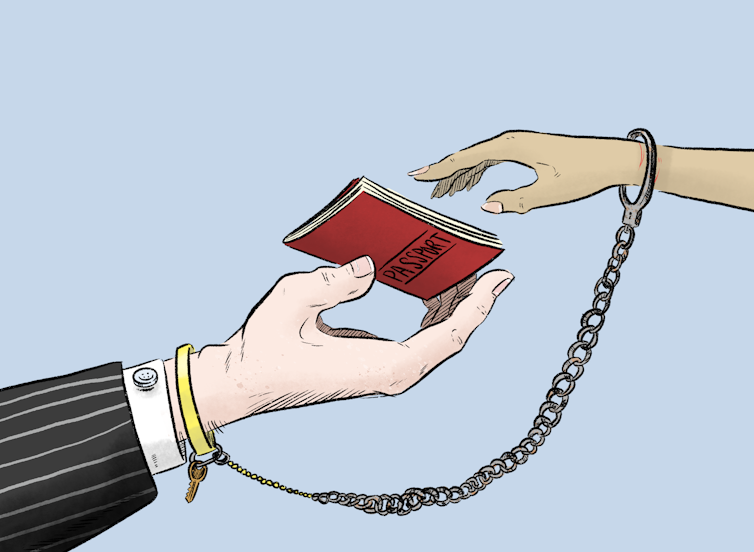
Many instances of slavery or exploitation start with the promise of a reasonably paying job in Australia. Wes Mountain/The Conversation, CC BY-ND
We might not want to believe it, but human trafficking and slavery happens in Australia. Slavery is not a historical artefact, but a tragic reality for millions of people around the world, including in Australia.
Recently, the term “modern slavery” has been used to contrast contemporary forms of slavery from historical slavery such as that seen during the transatlantic slave trade.
What is modern slavery?
In practice, modern slavery is an umbrella term that is often used to describe human trafficking, slavery and slavery-like practices such as servitude, forced labour and forced marriage.
But slavery is timeless. It has always been about the commodification of the body of a man, woman or child, the theft of liberty and sometimes life.
Anti-Slavery Australia, at the University of Technology Sydney, started researching and assisting trafficked and enslaved people in Australia back in 2002. For over 17 years, Anti-Slavery Australia has provided access to legal advice and assistance to hundreds of people who have experienced modern slavery.
In 2018 alone, Anti-Slavery Australia helped over 123 people who had been trafficked to or from Australia, or had faced slavery-like conditions while in Australia, including forced marriage, servitude and forced labour.
But this is just the tip of the iceberg. A recent report by the Australian Institute of Criminology estimates that only one in five victims are detected. This means that the cases we see are likely to be a small proportion of the scale of trafficking and slavery in Australia.
Vulnerable people of any background or status can be cruelly exploited. Some groups, such as migrant workers or young people, are more vulnerable than others.
Modern slavery in Australia
Below are four real-world examples, with names of individuals and businesses changed, to explain the different kinds of exploitation seen at Anti-Slavery Australia and considered in Australian courts.
Slavery
Essentially, slavery is when a person is controlled as if they were mere property.
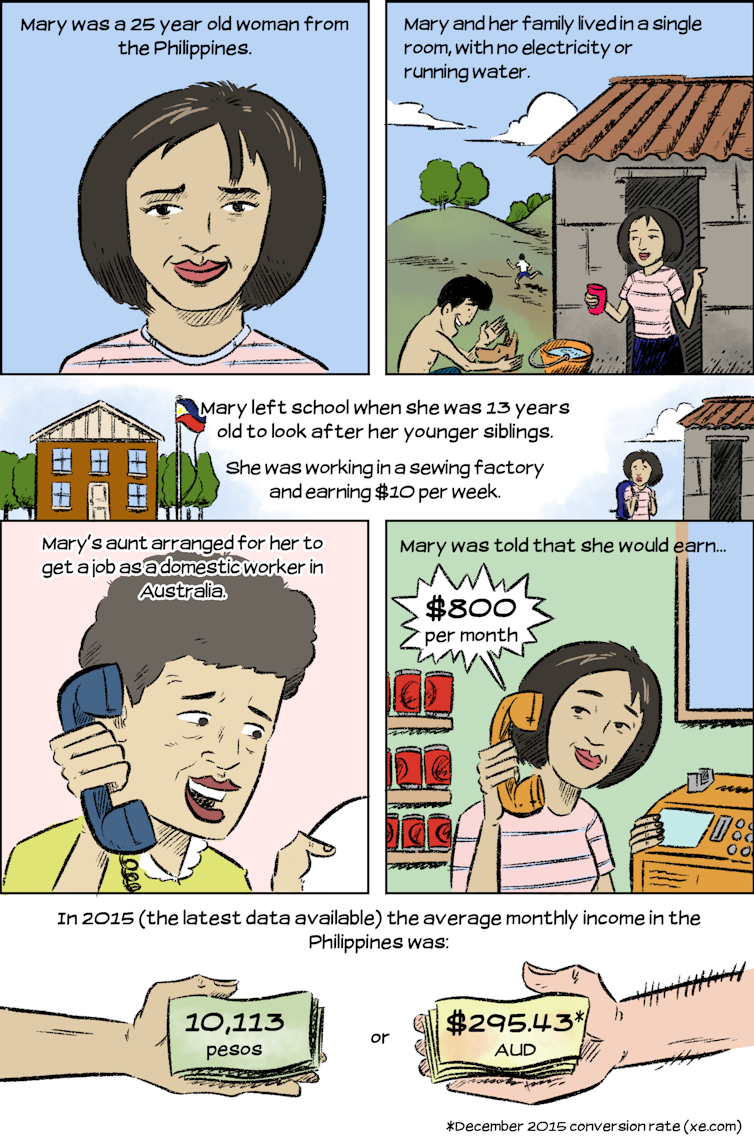
Wes Mountain/The Conversation, CC BY-ND
Description of slavery comic, part one
Page 1
We see a comic drawing of a young woman from the shoulders up.
Caption reads, ‘Mary was a 25 year old woman from the Philippines.’
Page 2
Mary stands at the entrance of a small countryside home holding a red drinking cup. She is smiling at a young man who enthusiastically pets a medium-sized dog. Between them is a bucket of water. In the distance, a young person runs up a hill.
Caption reads, ‘Mary and her family lived in a single room, with no electricity or running water.'
Page 3
13 year old Mary walks towards the entrance of her home, looking back over her shoulder to a two-storey school building. She wears a school backpack and has a concerned expression on her face.
Caption reads, ‘Mary left school when she was 13 years old to look after her younger siblings. She was working in a sewing factory and earning $10 per week.’
Page 4
A middle-aged woman with short curly hair speaks into a blue telephone receiver. She appears to be looking at a white piece of paper held in her left hand.
Caption reads, ‘Mary’s aunt arranged for her to get a job as a domestic worker in Australia.’
Page 5
Mary stands at a large yellow telephone, listening to the receiver. She looks weary but interested in what she’s hearing.
Caption reads, ‘Mary was told that she would earn…’ Speech-bubble coming out of the telephone reads, ‘$800 per month’
Page 6
Caption reads, ‘In 2015 (the latest data available) the average monthly income in the Philipines was:’ On the left, an outstretched arm holds a pile of notes, with text reading ’10,113 pesos’. Compared to … On the right, an outstretched arm holds a pile of notes, with text reading ‘$295.43* AUD’ (*December 2015 conversion rate xe.com).
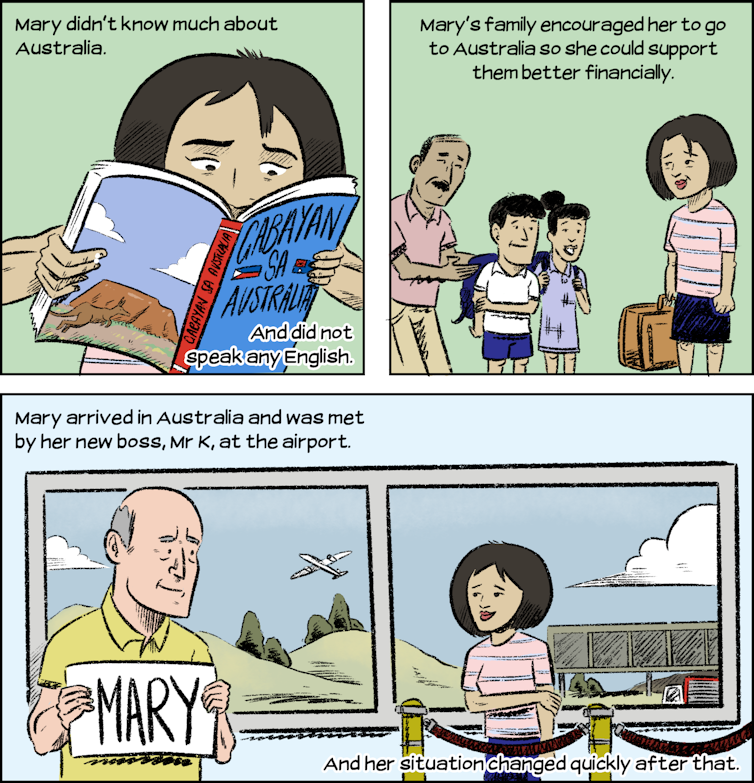
Wes Mountain/The Conversation, CC BY-ND
Description of slavery comic, part two
Page 1
Mary is closely reading a book titled ‘Gabayan SA Australia’, which has the Philippine and Australian flags on the front cover and Uluru and a kangaroo on the back.
Caption reads, ‘Mary didn’t know much about Australia. And did not speak any English.’
Page 2
Mary holds a brown suitcase and subtly smiles towards her family. The older man gestures towards two younger members of the family who wear school uniforms and backpacks.
Caption reads, ‘Mary’s family encouraged her to go to Australia so she could support them better financially.’
Part 3
Mary stands behind bollards at the exit of an airport, planes taking off in the background. Her body-language indicates nervousness as she looks towards a smiling older man who holds up a large sign with her name on it.
Caption reads, ‘Mary arrived in Australia and was met by her new boss, Mr K, at the airport. And her situation changed quickly after that.’
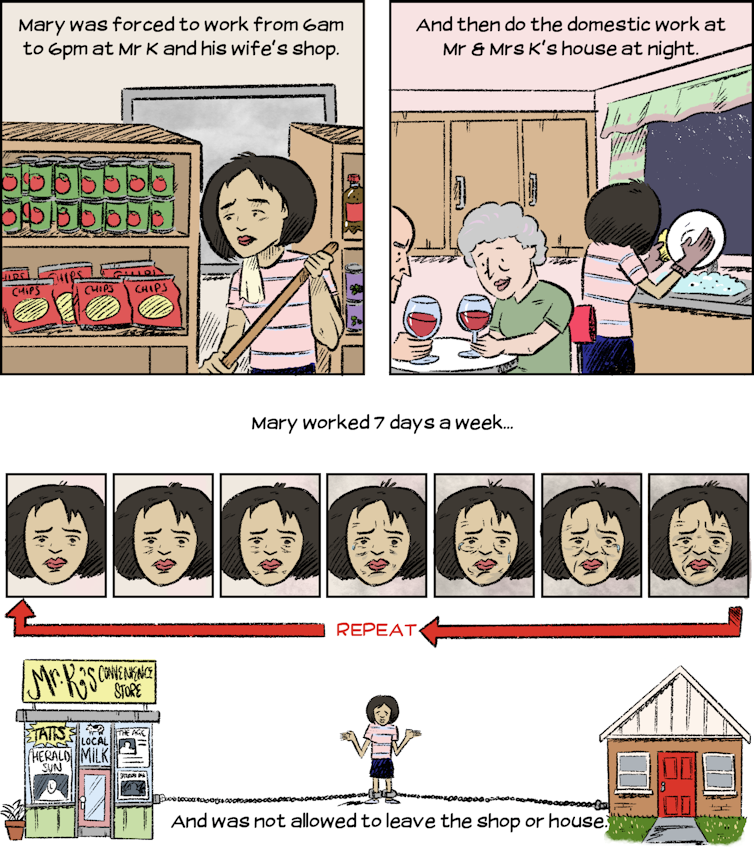
Wes Mountain/The Conversation, CC BY-ND
Description of slavery comic, part three
Page 1
Mary looks worn down and unhappy as she sweeps the floor of a grocery shop, a white rag strewn over her shoulder.
Caption reads, ‘Mary was forced to work from 6am to 6pm at Mr K and his wife’s shop.’
Page 2
Caption reads, ‘And then do the domestic work at Mr and Mrs K’s house at night…’
Mary is at the kitchen sink cleaning dishes as Mr and Mrs K sit at a table, smiling at one another with large glasses of red wine in hand.
Page 3
Caption reads, ‘Mary worked 7 days a week…’
A series of seven panels depict Mary’s face as it becomes increasingly ragged and miserable, with a red arrow and the word ‘repeat’ indicating the same cycle reoccurring every week.
Below, we see Mary standing between Mr K’s convenience store and a small house, chains tying her ankles to the buildings. She looks down at her feet, her hands in the air as she takes in her predicament.
Caption reads, ‘And was not allowed to leave the shop or house.’
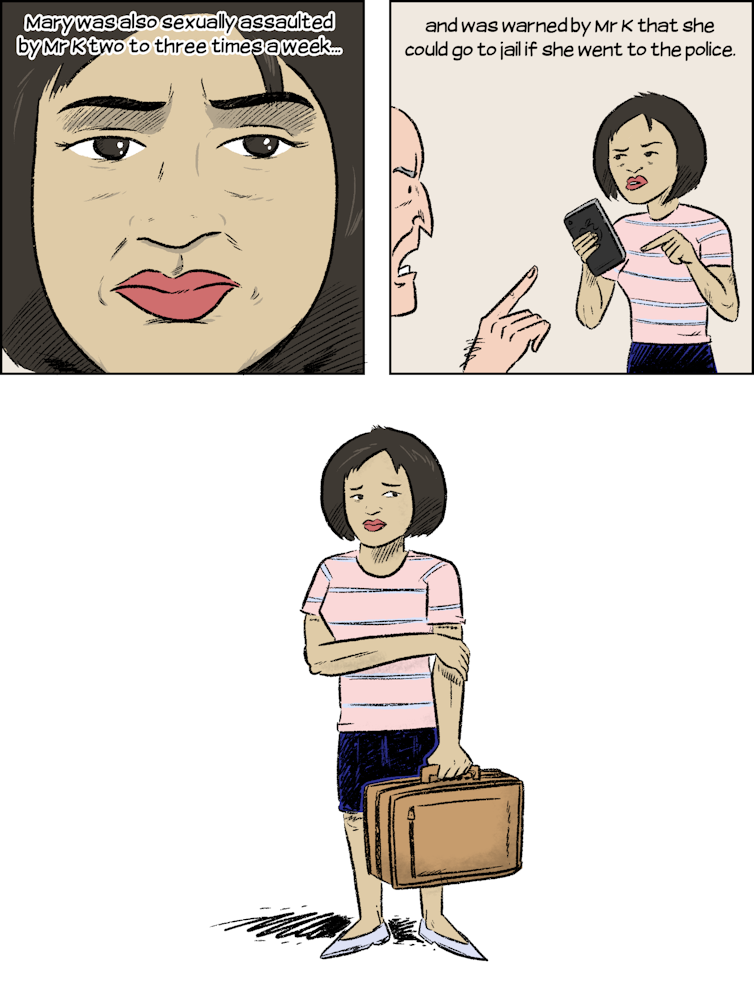
Wes Mountain/The Conversation, CC BY-ND
Description of slavery comic, part four
Page 1
A close-up image of Mary’s face, a furrowed brow and sadness in her eyes.
Caption reads, ‘Mary was also sexually assaulted by Mr K two to three times a week…’
Page 2
Mary appears to be in a heated argument with Mr K. She points to an iPhone she’s holding in her hand. Mr K points at her threateningly.
Caption reads, ‘and was warned by Mr K that she could go to jail if she went to the police.’
Page 3
Mary stands holding a briefcase, her eyes cast to the side and one hand protectively across her waist, gripping on to her other elbow.
Eventually, with the help of one of Mr and Mrs K’s family members, Mary was able to leave this situation.
This example is based on a case that ultimately led to Mr and Mrs K being found guilty of slavery offences and sentenced to eight and four years’ imprisonment respectively.
Servitude
Servitude is when a person does not consider themselves to be free to stop working or leave their workplace, because of threats, coercion or deception; and the person is significantly deprived of their personal freedom in their life outside of work.
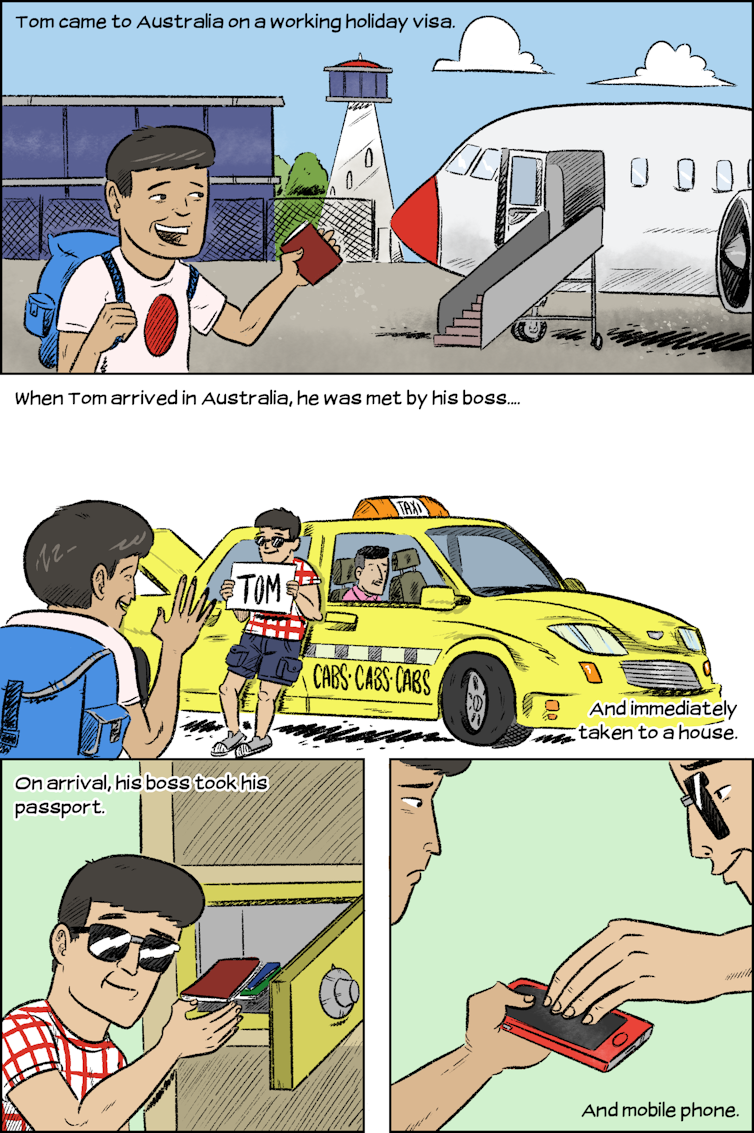
Wes Mountain/The Conversation, CC BY-ND
Description of servitude comic, part one
Page 1
A happy young man, Tom, stands on the airport tarmac, gesturing with his passport towards a plane he has either just arrived in or is about to board. He is wearing a Japanese flag t-shirt and a blue backpack.
Caption reads, ‘Tom came to Australia on a working holiday visa.’
Page 2
Tom waves at another young man, who wears dark sunglasses and is leaning against a yellow taxi cab holding up a large sign that reads ‘Tom’.
Caption reads, ‘When Tom arrived in Australia, he was met by his boss…’
Page 3
Tom’s boss stashes different coloured passports into a small safe.
Caption reads, ‘On arrival, his boss took his passport.’
Page 4
Tom looks displeased as he hands his red phone over to his smiling boss.
Caption reads, ‘And mobile phone.’
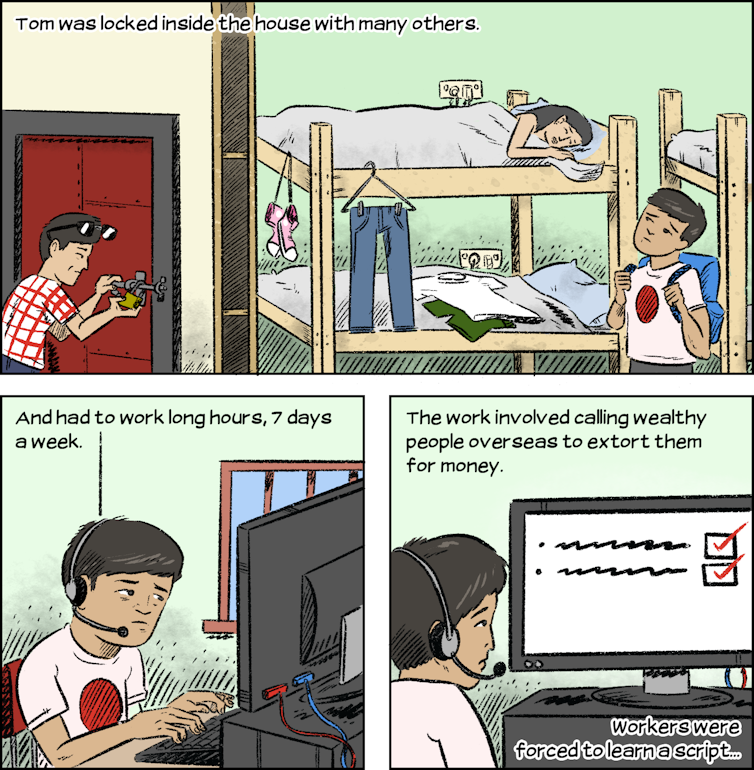
Wes Mountain/The Conversation, CC BY-ND
Description of servitude comic, part two
Page 1
Tom, still wearing his blue backpack, stands in a dorm room of several bunkbeds, a concerned expression on his face as he looks up at a young woman awake in bed. Items of clothing hang from her bunk and lay on the bed below hers. Outside, Tom’s boss is locking a large door bolt.
Caption reads, ‘Tom was locked inside the house with many others.’
Page 2
Tom looks fatigued as he wears a headset and types at a desktop computer. A small, barred window is beside his desk.
Caption reads, ‘And had to work long hours, 7 days a week.’
Page 3
Tom looks up at his computer screen, which displays a checklist.
Caption reads, ‘The work involved calling wealthy people overseas to extort them for money. Workers were forced to learn a script…’

Wes Mountain/The Conversation, CC BY-ND
Description of servitude comic, part three
Page 1
A bar chart indicates the time of day spent calling people (7.40am to 4.45pm) and learning scripts (4.45pm to 9.30pm).
Caption reads, ‘He worked from 7.40am to 9.30pm every day.’
Page 2
Caption reads, ‘And he and others were told when they could…’
Three panels show Tom and two other exploited people as they eat, sleep and shower, a clock positioned prominently on the wall above their heads.
Page 3
Tom looks dejected as he stands across from his boss, holding open his empty wallet while his frowning boss indicates towards a list of bills owed.
Caption reads, ‘Tom was not paid any wages for his work.’
Eventually, Tom managed to escape from the house, flagged down a motorist and contacted police. Police responded and found 49 other exploited people who had been coerced and controlled.
This example is based on a case that led to two people being found guilty of causing a person to enter into or remain in servitude and sentenced to three years’ and two-and-a-half years’ imprisonment.
Forced labour
Forced labour is when a person does not consider themselves free to stop working, or to leave their workplace, because of threats, coercion or deception.
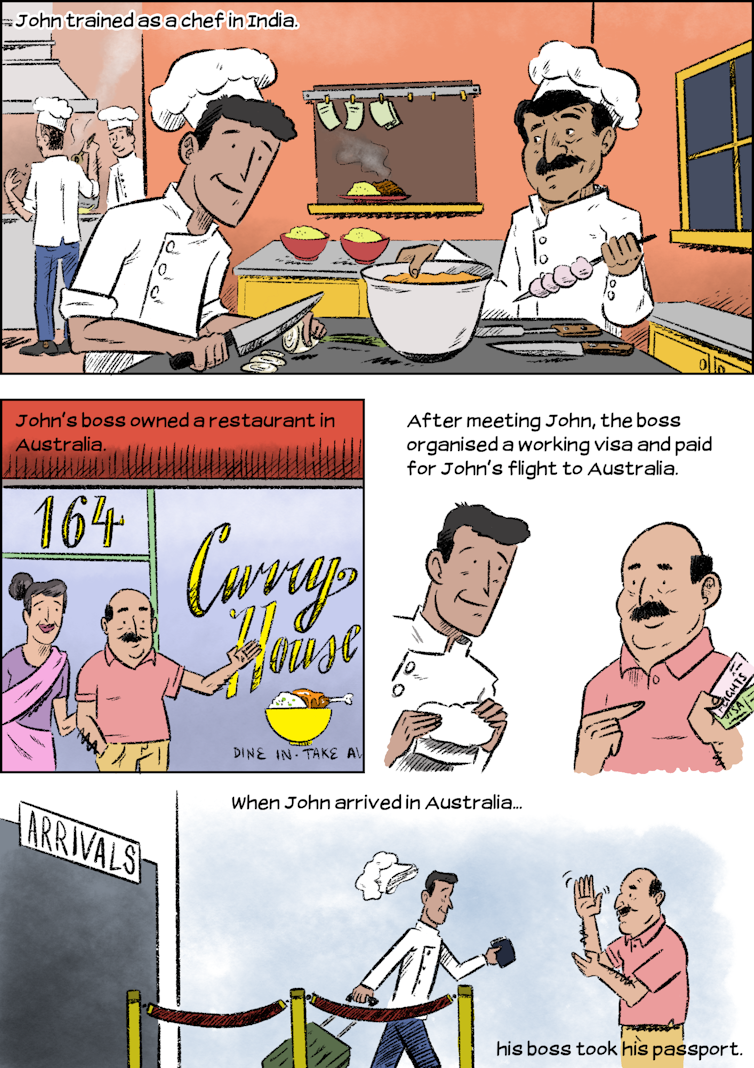
Description of forced labour comic, part one
Page 1
John preps food with other chefs in a professional kitchen.
Caption reads, ‘John trained as a chef in India.’
Page 2
An older couple strand in front of a restaurant Curry House restaurant, the older man casually waves a greeting.
Caption reads, ‘John’s boss owned a restaurant in Australia.’
Page 3
John smiles at his boss, who points to documents in his hand that read ‘flights’ and ‘visa’.
Caption reads, ‘After meeting John, the boss organised a working visa and paid for John’s flights to Australia.’
Page 4
John strides through the arrivals gate at the airport pulling his wheel suitcase, his chef’s hat flying off his head. His boss greets him with a friendly wave and holds out his hand for John’s passport.
Caption reads, ‘When John arrived in Australia… his boss took his passport.’

Wes Mountain/The Conversation, CC BY-ND
Description of forced labour comic, part two
Page 1
A ‘time-lapse’ of a miserable and unshaved John as he prepares food, reads, and sleeps under a table in the restaurant kitchen, which has bars on the windows.
Caption reads, ‘John discovered he would have to… work, live, and sleep …in the restaurant.’
Page 2
John’s boss turns the key in the lock of a door which displays a large sign reading, ‘employees only’.
Caption reads, ‘At night, John was locked in the restaurant storeroom...’
Page 3
A sad-looking John tries turning the door handle from the inside.
Caption reads, ‘and had no key or any access to a bathroom until the owner returned in the morning.’
Page 4
John frowns down at a bowl of hot rice, fork in hand.
Caption reads, ‘John had limited food to eat.’
Page 5
Caption reads, ‘And few breaks, as he worked from’
John sits with his head in his hands, a clock to his left reading ‘8 am’ and a clock to his right reading ‘midnight.’
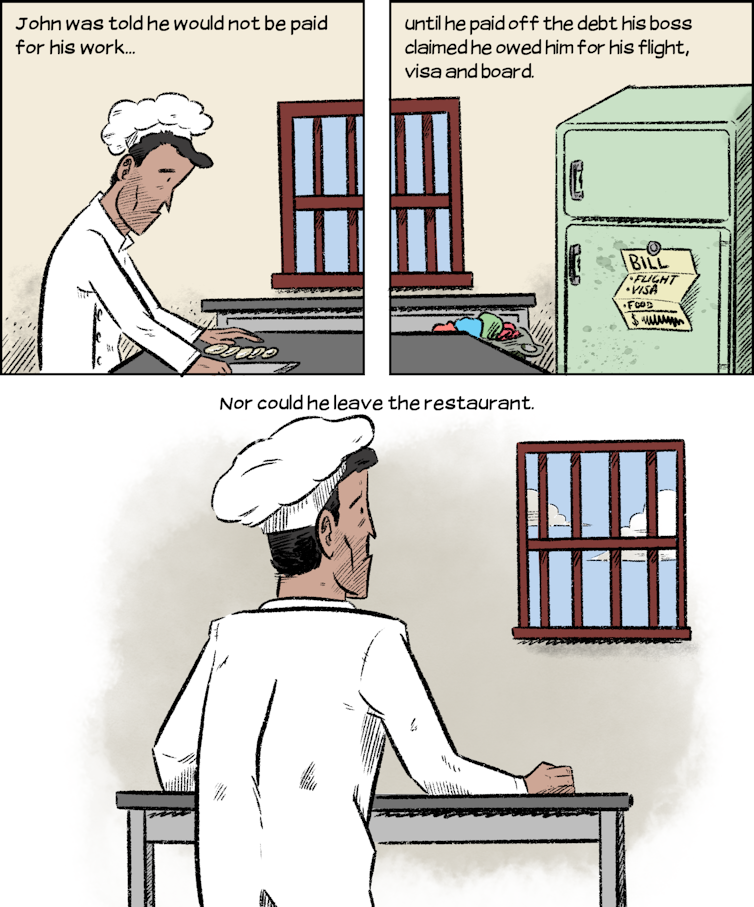
Wes Mountain/The Conversation, CC BY-ND
Description of forced labour comic, part three
Page 1
John looks forlornly down at the chopped vegetables in front of him, knife hand resting on the tabletop.
Caption reads, ‘John was told he would not be paid for his work…’
Page 2
Caption reads, ‘until he paid off the debt his boss claimed he owed for his flight, visa and board.’
A document stuck on to the fridge door lists bills owed, including flights, visa and food.
Page 3
John looks at the cloudy sky, bars on the windows blocking any escape.
Caption reads, ‘Nor could he leave the restaurant.’
Eventually, John was able to get help, but he was in very poor health and died a few years later.
Forced marriage
A forced marriage is when a person is married without freely and fully consenting because of either coercion, threat or deception. It could also be because they’re incapable of understanding the nature and effect of a marriage ceremony, possibly because of their age or mental capacity.
A forced marriage is different from an arranged marriage or a sham marriage. The main difference is that there is consent in arranged and sham marriages.
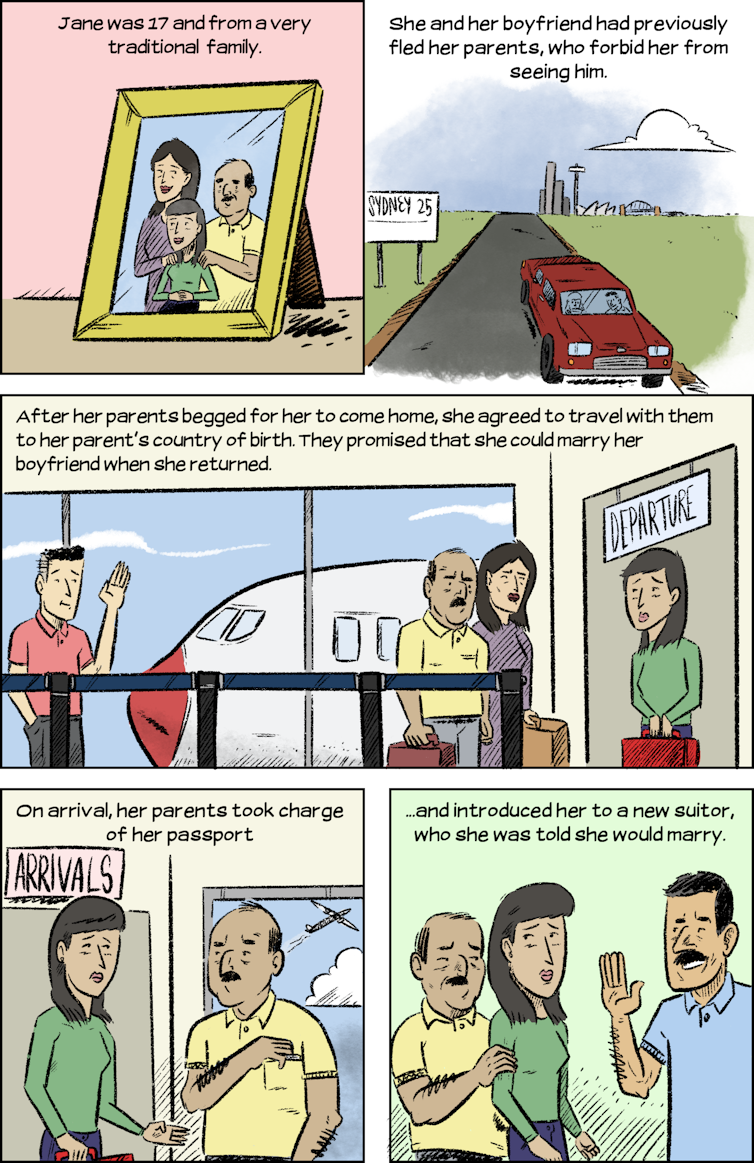
Wes Mountain/The Conversation, CC BY-ND
Description of forced marriage comic, part one
Page 1
A framed photograph depicts a family of two parents, their hands on their daughter Jane’s shoulders.
Caption reads, ‘Jane was 17 and from a very traditional family.’
Page 2
Jane and her boyfriend are driving down a road, the Sydney skyline in the background.
Caption reads, ‘She and her boyfriend had previously fled her parents, who forbid her from seeing him.’
Page 3
Jane stands at the departure gate of an airport, suitcase in hand as she looks past her stern parents to her boyfriend, who casually waves goodbye.
Caption reads, ‘After her parents begged for her to come home, she agreed to travel with them to her parent’s country of birth. They promised that she could marry her boyfriend when she returned.’
Page 4
Jane stands with her father at the arrivals gate. His hand touches his shirt pocket, where he appears to have secured her passport.
Caption reads, ‘On arrival, her parents took charge of her passport’
Page 5
Caption reads, ‘…and introduced her to a new suitor, who she was told she would marry.’
Jane looks apprehensive as her father grips her by the arms, holding her in front of an older man who waves hello.
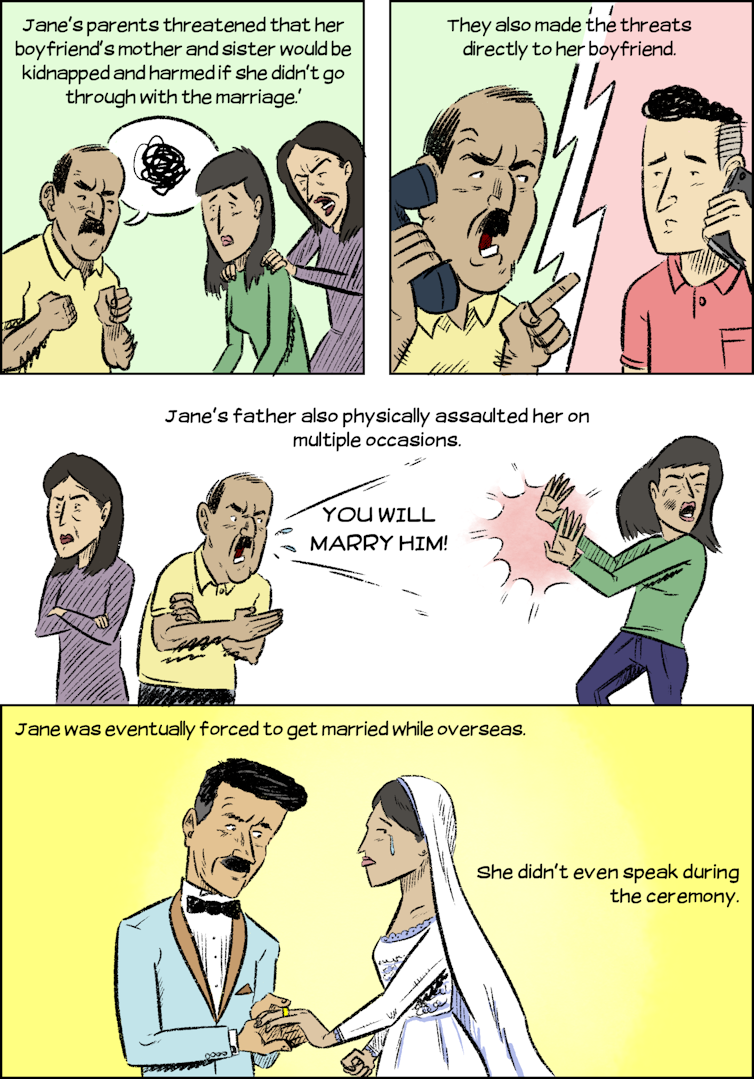
Wes Mountain/The Conversation, CC BY-ND
Description of forced marriage comic, part two
Page 1
Jane looks worried as she stands hunched between her parents, her angry mother gripping her by the shoulders and her frowning father holding up two fists. A speech bubble indicates he is saying angry words.
Caption, ‘Jane’s parents threatened that her boyfriend’s mother and sister would be kidnapped and harmed if she didn’t go through with the marriage.’
Page 2
Jane’s father speaks and points with aggression while on the phone to Jane’s boyfriend.
Caption, ‘They also made the threats directly to her boyfriend.’
Page 3
Jane holds up her hands and turns her head away to protect herself as her father shouts, ‘you will marry him!’. Her mother faces the other way, arms crossed.
Caption reads, ‘Jane’s father also physically assaulted her on multiple occasions.’
Page 4
Wearing a white bridal gown and veil, Jane cries as the man her father introduced her to pushes a wedding band onto her ring finger.
Caption reads, ‘Jane was eventually forced to get married while overseas. She didn’t even speak during the ceremony.’
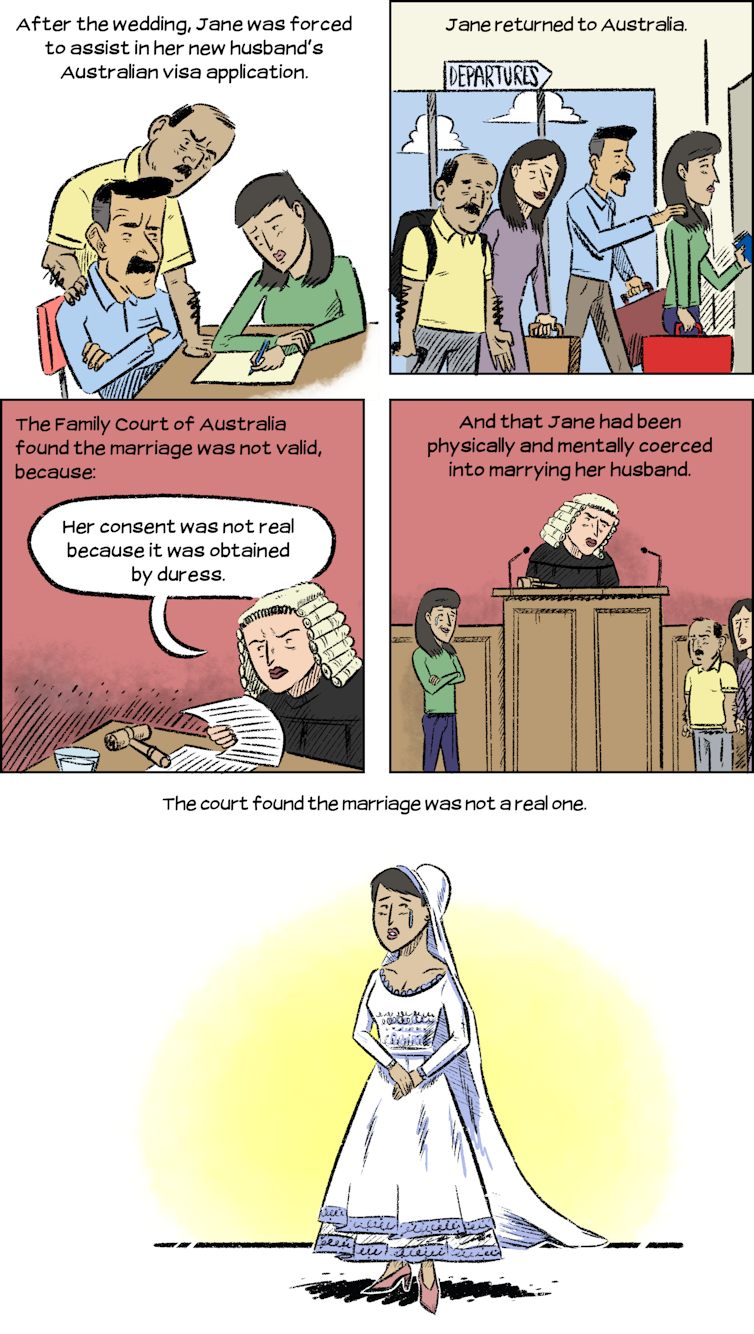
Wes Mountain/The Conversation, CC BY-ND
Description of force marriage comic, part three
Page 1
Jane looks dejected as she sits at the table with her new husband, filling out paperwork while he sits with his arms crossed. Her father has his hand on her new husband’s shoulder, sternly watching over her work.
Caption reads, ‘After the wedding, Jane was forced to assist in her new husband’s Australian visa application.’
Page 2
Jane, her new husband, and her parents carry suitcases as they walk into the departures gate at the airport.
Caption reads, ‘Jane returned to Australia.’
Page 3
Caption reads, ‘The Family Court of Australia found the marriage was not valid, because:’
‘Her consent was not real because it was obtained by duress,’ says a judge, frowning down at paper documents.
Page 4
Caption reads, ‘And that Jane had been physically and mentally coerced into marrying her husband.’
Jane cries happy tears, her arms crossed confidently, as she stands in court across from her parents, the judge giving them a stern look.
Page 5
Jane stands wearing her wedding dress, a tear rolling down her cheek.
Caption reads, ‘The court found the marriage was not a real one.’
* Names of individuals and businesses have been changed for confidentiality
To find out more about the scenarios you have read, additional information and confidential legal advice contact Anti-Slavery Australia. See www.antislavery.org.au. For information and advice on forced marriage see www.mybluesky.org.au.
This is an edited version of a story that appeared in The Conversation.
Jennifer Burn is a Professor of Law at Anti-Slavery Australia at University of Technology Sydney. She’s also the NSW Interim Anti-Slavery Commissioner.

